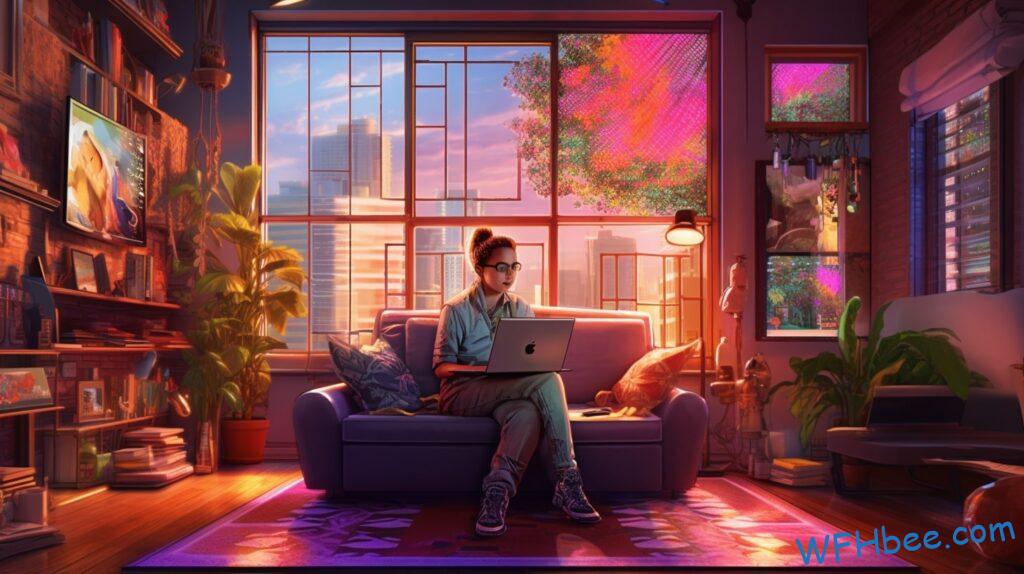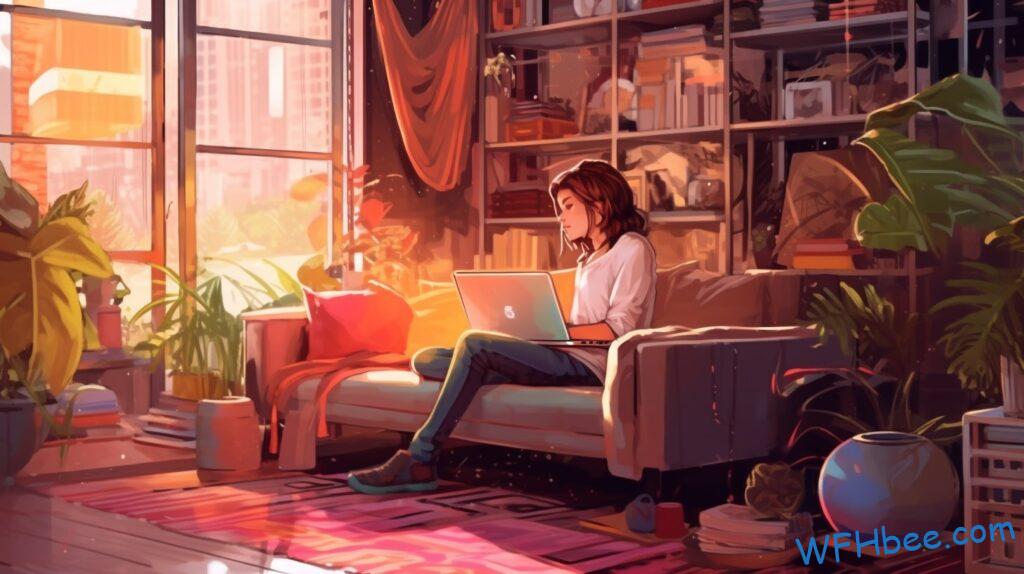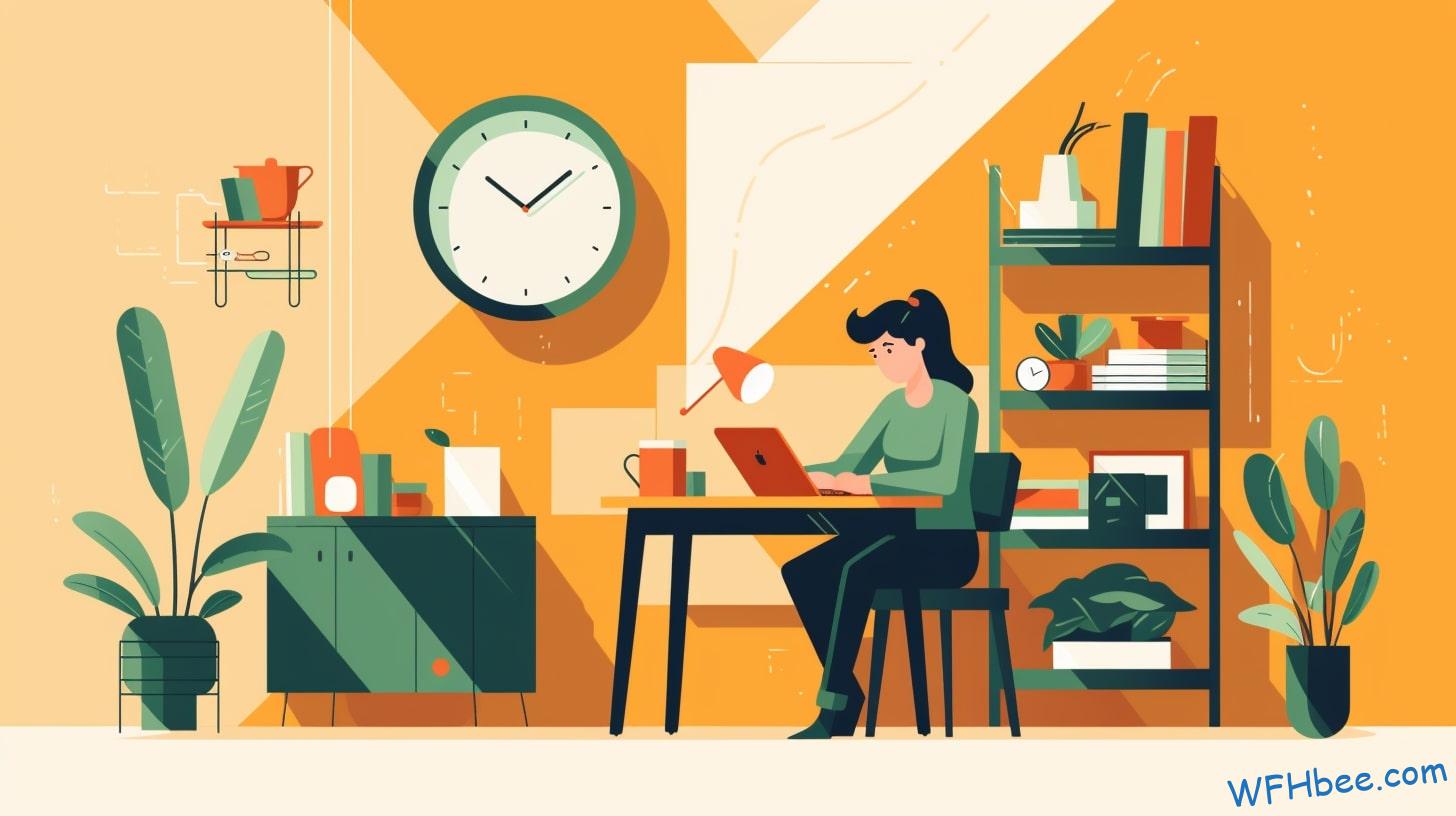In this article, we’ll explore how you can set up your workspace at home without a desk – and still get things done!
Imagine being able to work from anywhere you please: on the couch, outside, or even working in bed. It’s possible with the right setup – no matter what size work-from-home space you have available. From cozy nooks to minimalistic setups, everyone can find something that works for them. And if you don’t have room for large furniture pieces like desks? No worries! We’ve got plenty of ideas so you can maximize your productivity while enjoying freedom and flexibility.
So let’s take a closer look at how to make working remotely without a desk an enjoyable experience. Here are some tips to help you create an efficient yet comfortable workspace wherever life takes you!

Table of Contents

Benefits Of Working From Home
Working from home has become increasingly popular in recent years for its numerous benefits. For starters, remote flexibility allows one to work on their own time and from any location. There is no need to battle traffic or deal with the stress of a long commute every day. Plus, working from home can save you money as there’s no need to spend extra cash on transportation costs. You can even set your own schedule, allowing you to take breaks whenever you choose without having to worry about setting aside too much or too little time for each task.
These are all great reasons why many people opt for this type of arrangement; however, it does come with some risks that should be addressed before diving in headfirst.

By the way, you may also want to read this ultimate guide to working virtually without an office! (Click to read the post.)
Risks Of Working Without A Desk
Working without a desk can be detrimental to your health. Ergonomic injuries, back problems, and neck strain are all risks associated with working from home without an appropriate workspace. Here’s what you should consider:
- Poor posture can cause musculoskeletal discomfort in the short-term, but it can also lead to long-term issues that may interfere with productivity as well as comfort.
- Working on a bed or couch is not ideal because these surfaces don’t provide adequate support for extended periods of time, nor do they promote proper ergonomics, which leads to poor posture and increased risk of injury.
- Sitting without adequate back support removes the opportunity to move around and stretch throughout the day; this may increase the likelihood of developing aches and pains due to repetitive motions like typing or mouse clicking.
The bottom line? Not having a dedicated workspace at home could result in serious medical complications if left unchecked –– so take steps now to create one! The right setup won’t just reduce your risk of physical ailments but will also help keep you motivated and productive while working remotely.

Alternatives To Using A Desk
For those working from home without a desk, there are alternatives to help create an effective workspace. A lap tray is perfect for providing a flat surface on which to place your laptop and work materials while seated in bed or on the couch. Standing tables can also be used as makeshift desks by placing them against the wall or up against furniture. If you prefer to use a regular chair, then investing in a quality laptop stand may be beneficial; it will allow you to adjust the height of your laptop so that it’s at eye-level when sitting in the chair.
No matter what type of stationery items you decide to use, make sure they’re comfortable and ergonomic – this will help ensure that you remain productive throughout the day. Additionally, optimizing lighting and sound levels within your workspace can also have a direct impact on how well you focus and complete tasks. Without proper light and sound levels, it becomes difficult to concentrate for extended periods of time.

Optimizing Lighting And Sound For Productivity
Creating a successful workspace at home without a desk can seem like an uphill battle. But with the right lighting and sound optimization, you can make your remote space come alive in no time!
When it comes to optimizing lighting for productivity, natural light is best. Place lamps near windows or on shelves to increase visibility while working. Consider investing in adjustable LED bulbs that allow you to adjust the brightness of each bulb according to the task at hand. This will help reduce eyestrain and headaches from staring at a screen all day long.
On the other side of things, sound plays a major role in maintaining focus when working remotely. Investing in noise-cancelling headphones or setting up music playlists are great ways to stay productive during work hours. You may also want to consider playing some white noise over speakers if ambient noises (like traffic) tend to distract you throughout the day. Make sure not to put your volume too high though – this could lead to further distractions as well!
The key here is balance: finding what works best for both your eyes and ears so that you can keep focused on your tasks without getting overwhelmed by any one element of your environment. With just these few simple steps, anyone can create a comfortable and productive workspace even without a desk!

Making The Most Out Of Limited Space
Making the most out of limited space is essential when working from home without a desk. Fortunately, there are plenty of creative solutions that can help you maximize your small space and make it work for you.
Space-saving furniture such as wall shelves or folding desks can provide ample storage and workspace while taking up minimal floor area.
A standing desk converter might be another great option if you don’t have room to dedicate an entire table to your office setup.
Additionally, consider investing in quality furniture and equipment so that you can get the job done without sacrificing comfort or function. Investing in ergonomic chairs and adjustable monitor arms will enable you to create a functioning workspace even with limited square footage.
With these strategies in mind, you’ll be well on your way towards creating the perfect home office within whatever space constraints you may have!
Setting Up A Filing System
If you’re working from home without a desk, setting up an effective filing system is essential. With the right organization, you can easily keep track of documents and papers that are integral to your work. Filing organization starts with designating a spot in your workspace for all incoming mail, paperwork, notes and other items. Then create a plan for document organization by categorizing your materials into folders or sections based on their purpose. This will make it easier to locate them when needed. It’s also important to establish categories for paper organization as well; this includes archiving old records and discarding unnecessary ones.
Organization isn’t only beneficial for efficiency – it’s also key for staying productive while working from home without a desk! By utilizing technology such as cloud storage services, scanning apps and digital receipts, you’ll have better access to the information you need whenever necessary. The next step is learning how to use these resources effectively for maximum efficiency.

Prioritizing Safety & Health
We must prioritize safety and health when working from home. Working without a desk can create ergonomic issues. It’s important to consider factors such as posture, keyboard placement, and monitor height before settling in to your makeshift workstation.
Occupational Health professionals recommend taking frequent breaks throughout the day and utilizing proper ergonomics at each station. This involves using equipment like footrests or laptop stands to ensure correct alignment of body position while typing or scrolling on devices. Additionally, it is recommended to stretch regularly and take walks around the house every hour or so. Establishing good habits now will help prevent any future physical discomfort related to extended periods of sitting improperly.
By following these guidelines, you can hopefully maintain productivity while staying safe and healthy in your own space, even without a desk! ecific tasks throughout the day, making it easier to stay focused and productive – even without a dedicated office space!

Implementing Smart Scheduling Practices
Scheduling smartly is essential for working from home without a desk. It’s time to take control of your own destiny, and that means taking charge of how you spend your days. With the right scheduling practices, it’s possible to maintain an effective work-life balance while still getting everything done. Here are some tips on creating the ultimate schedule:
First, make sure to plan ahead when crafting out each day’s tasks. Prioritize any urgent items first – this will help keep you organized and focused as well as prevent procrastination. Also set aside specific times throughout the day when you’ll dedicate yourself solely to completing necessary tasks or projects; this way, distractions won’t come in the way of productivity. Finally, don’t forget about taking regular breaks & stretches – these are key for staying energized and avoiding burnout!

Taking Regular Breaks And Stretches
Taking regular breaks and stretching throughout your workday is an important part of staying healthy while working from home, especially if you don’t have the optimal setup with a proper desk! Breaks give you time to take mental health breaks, stretch out sore muscles, grab a snack or cup of coffee, and refresh yourself for the next task at hand. Here’s how you can incorporate breaks into your daily routine:
- Take short walks every hour or two
- Step away from your desk at lunchtime for 15-20 minutes
- Set an alarm to remind yourself when it’s time for a break
- Get up and do some light stretches during the day
Having adequate rest periods will help keep your mind and body energized so that you stay productive and creative throughout the WFH day. When you’re feeling overwhelmed with deadlines and tasks, taking even just five minutes away from your desk can be enough to clear your thoughts and get back on track. Plus, regular breaks are essential in preventing burnout as they provide opportunities to focus on something other than work. This helps create balance between productivity levels and well-being – key components of success when working remotely!

Strategies To Avoid Burnout
Burnout is a common experience for those who work from home without the structure and proper equipment of an office job. It’s important to have strategies in place to help avoid it and stay productive. Here are some key tips for avoiding burnout when working from home:
- Establish routines and stick to them: Creating a daily routine can help you keep on track with your goals and manage stress levels. This includes setting aside time for rest, exercise, healthy eating, and activities that bring joy.
- Take breaks throughout the day: Taking short breaks throughout the day allows your mind and body to recharge while keeping productivity high. Consider taking 15 minutes away from screens every hour or so to do something like stretching or going outside.
- Practice effective time management: Keeping close tabs on how long tasks take will make it easier to plan ahead and set realistic expectations for yourself. Prioritize essential tasks first, then fill out any remaining open spaces with enjoyable activities such as reading or leisurely walking.
- Incorporate stress management techniques: Stress management techniques such as mindfulness meditation, deep breathing exercises, journaling, yoga, etc., can all be helpful tools in managing feelings of overwhelm and fatigue. Make sure to incorporate at least one into your daily practice!
When it comes down to it, having proper self care habits is paramount when trying to maintain good mental health when working remotely. Setting boundaries between work life and personal life goes a long way towards reducing stress levels and creating balance in our lives – something we could all use more of these days!

Conclusion
Working from home without a desk can potentially be done successfully, but it does require some extra effort and planning.
Overall, being successful at working from home without a desk requires careful consideration of how to create an effective environment for productivity. With just a few simple adjustments, you can hopefully maximize your efficiency and minimize any potential risks associated with not having a desk or dedicated workspace. So go ahead – give it a try!
Author: Robin Borg
Hi, I’m Robin. I have been working from home at least one day a week during all of my adult life. I have a background in research and data science. Get to know me better in the About page.







